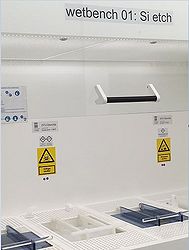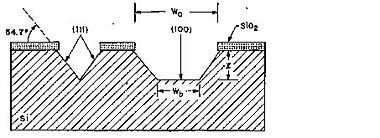Specific Process Knowledge/Etch/KOH Etch: Difference between revisions
| Line 18: | Line 18: | ||
<gallery caption="Different places to do anisotropic wet silicon etch" widths="350px" heights="250px" perrow="3"> | <gallery caption="Different places to do anisotropic wet silicon etch" widths="350px" heights="250px" perrow="3"> | ||
image:KOH_BHF.JPG|Wetbench 01 Si etch, for SI etch of 4" and 6" wafers using KOH. Positioned in cleanroom D-3. | image:KOH_BHF.JPG|Wetbench 01: Si etch, for SI etch of 4" and 6" wafers using KOH. Positioned in cleanroom D-3. | ||
image:KOH_fumehood.JPG|Fume hood 06: Si etch, for SI etch of 4" and 6" wafers using KOH. Positioned in cleanroom D-3. This is used for wafers that are considered dirty.</gallery> | image:KOH_fumehood.JPG|Fume hood 06: Si etch, for SI etch of 4" and 6" wafers using KOH. Positioned in cleanroom D-3. This is used for wafers that are considered dirty.</gallery> | ||
Revision as of 11:42, 23 February 2017
Feedback to this page: click here
THIS PAGE IS UNDER CONSTRUCTION
KOH etch - Anisotropic silicon etch
KOH belongs to the family of anisotropic Si-etchants based on aqueous alkaline solutions. The anisotropy stems from the different etch rates in different crystal directions. The {111}-planes are almost inert whereas the etch rates of e.g. {100}- and {110}-planes are several orders of magnitude faster.
KOH-etching is a highly versatile and cheap way to realize micro mechanical structures if you can live with the necessary Si3N4- or SiO2-masking materials and the potassium contamination of the surface. The latter necessitates in most cases a wet post-clean ('7-up' or RCA-clean) if the wafer is to be processed further.
At Danchip we use as a standard a 28 wt% KOH. The etch rate - and the selectivity towards a SiO2-mask - is depending on the temperature. We normally use T=80 oC but may choose to reduce this to e.g. 60 oC or 70 oC in case of a high-precision timed etch (e.g. defining a thin membrane). In some cases we recommend to saturate the standard 28 wt% KOH with IPA with an etch temperature at T=70 oC (reduce evaporation of IPA). One example is for boron etch-stop, where the selectivity towards the boron-doped silicon is improved compared to the standard etch. Etching with IPA added to the KOH solution can be done in KOH fumehood.
- Different places to do anisotropic wet silicon etch
-
Wetbench 01: Si etch, for SI etch of 4" and 6" wafers using KOH. Positioned in cleanroom D-3.
-
Fume hood 06: Si etch, for SI etch of 4" and 6" wafers using KOH. Positioned in cleanroom D-3. This is used for wafers that are considered dirty.
The user manuals, quality control procedures and results, user APVs, technical information and contact information can be found in LabManager:
Fumehood KOH info page in LabManager
Process Information
Quality Control (QC) for the KOH etching baths.
| Quality Control (QC) for KOH1, KOH2 and KOH3 | ||||||||||||||||||||||||||
|
KOH etching baths
Key facts for the different etch baths available at Danchip are resumed in the table:
| Equipment | KOH3 | KOH2 | KOH1 | KOH Fumehood | |
|---|---|---|---|---|---|
| Purpose | Wet etch of Silicon |
|
|
The bath is dedicated wafer with electroplated Nickel or otherwise dirty wafers |
|
| Link to safety APV and KBA | |||||
| Performance | Etch rates in crystalline silicon (100) |
|
|
Etch rates might vary due to contamination and poor controlled concentration of the KOH solution |
|
| Etch rates in Thermal SiO2 |
|
|
|||
| Etch rates in SiN |
|
||||
| Roughness |
|
|
|
| |
| Anisotropy |
|
|
|
| |
| Process parameter range | Chemical solution |
KOH:H2O - 500 g : 1000 ml, when using pills KOH:H2O - 1000 ml: 1200 ml, when using premixed 50% KOH solution |
KOH:H2O - 500 g : 1000 ml, when using pills KOH:H2O - 1000 ml: 1200 ml, when using premixed 50% KOH solution |
KOH:H2O - 500 g : 1000 ml, when using pills KOH:H2O - 1000 ml: 1200 ml, when using premixed 50% KOH solution |
|
| Temperature |
|
|
|
| |
| Substrates | Batch size |
|
|
|
|
| Size of substrate |
|
|
|
| |
| Allowed materials |
|
|
|
| |
| Masking material |
|
|
|
| |
1 Measured by Eric Jensen from DTU-Nanotech, October 2013.
Definition of structures
Due to the almost inert (111)-planes it is possible by KOH etching to realize high aspect ratio structures in sigle crytalline silicon using the (111)-planes as sidewalls. In Si(100) these sidewalls are inclined - 54.7o with respect to the (100) surface - whereas in Si(110) the sidewalls are vertical (see figures below).
- Anisotropic wet silicon etch: dependency on crystal orientation
-
Etched profile when etching Si(100).
-
Etched profile when etching Si(110).
For Si(100), the relation between the width of the bottom of the etched groove (Wb) and the width of the opening (Wo) at the wafer surface in a groove etched to the depth l is given by:
Definition of <110> alignment structures
The etch rate dependence on the crystallographic planes can be used to determine the <110> crystal directions with high precision (better than +/- 0.05 o). A fast method for doing this, using the symmetric under-etching behavior around but not at the <110>-directions, was described by Vangbo and Bäcklund in J. Micromech. Microeng.6 (1996), 279-284. High-precision control of the <110>-direction during alignment can be necessary in order to control the dimensions of KOH-etched structures (e.g. precise control of V-groove dimensions). A dedicated mask (MASK NAME) has been designed for this purpose.
Etch rates: Empirical formula (Seidl et al)
The following empirical formula can be used for concentrations in the range of 10-60 wt%:
R = k0 [H2O]4 [KOH]0.25 e-Ea/kT,
where k0 = 2480 µm/hr (mol/l)-4.25, Ea = 0.595 eV for Si(100)
and k0 = 4500 µm/hr (mol/l)-4.25, Ea = 0.60 eV for Si(110)




